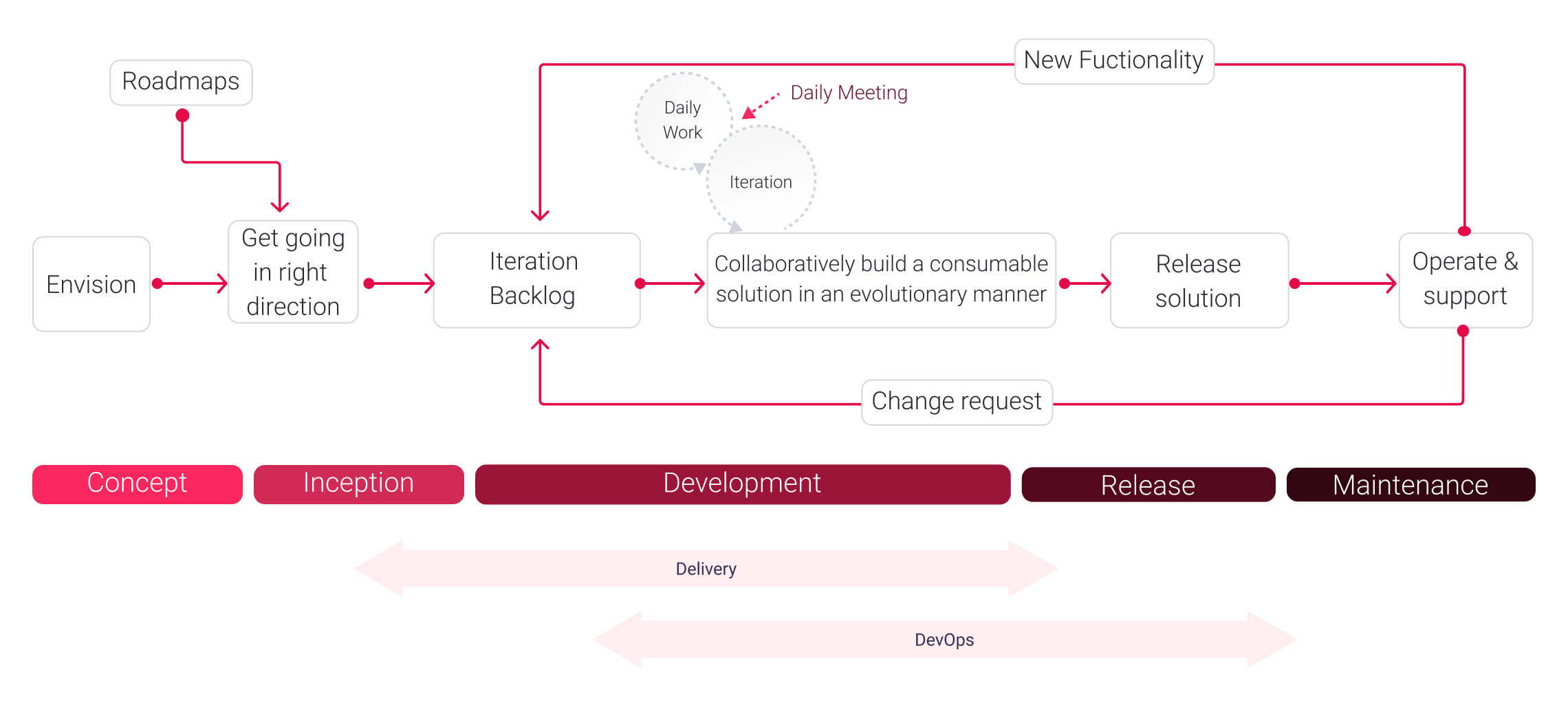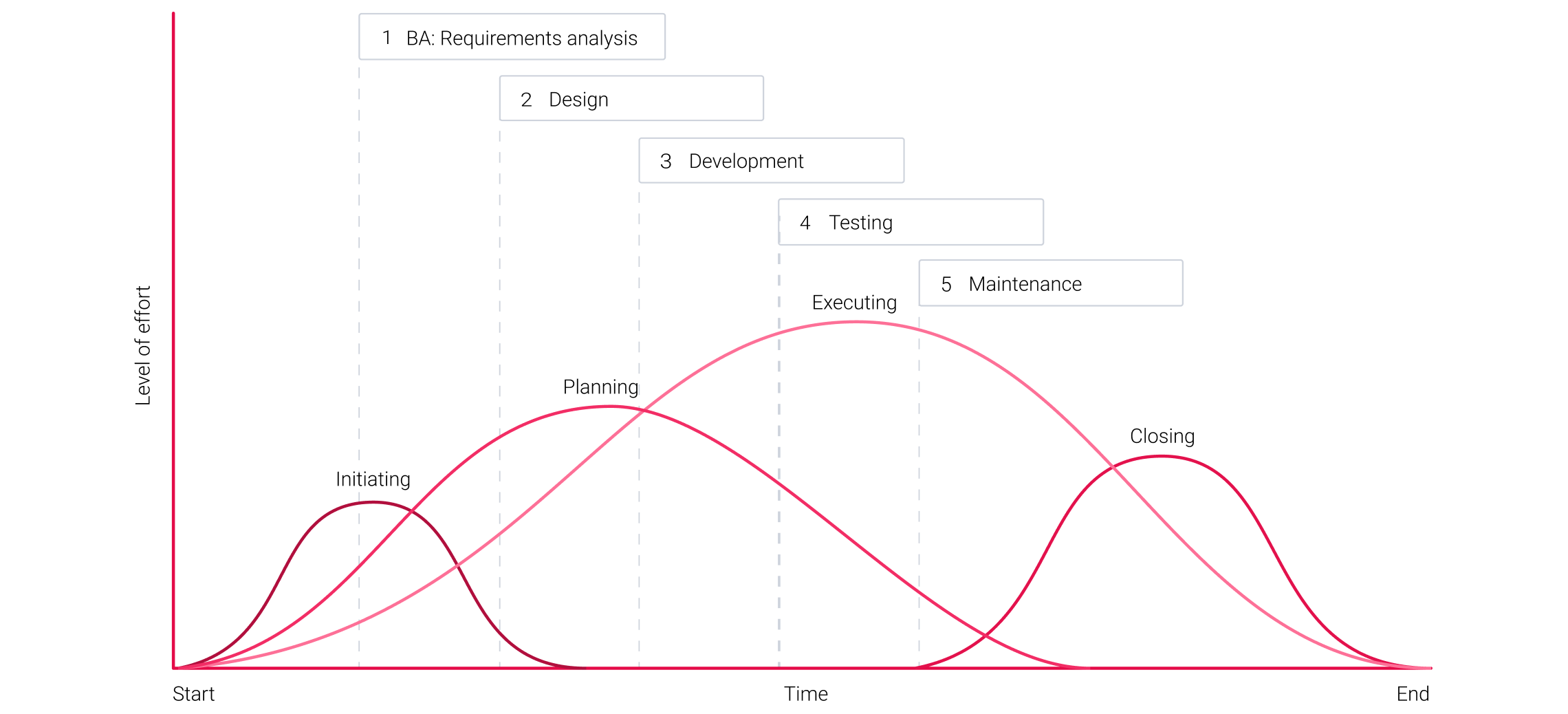How We Work
Starting from the moment of your request and throughout the project we direct all energy and efforts to be your reliable partner. We ensure transparent communication and timely updates at every stage. Our commitment to excellence guarantees that your needs are met with the highest standards.
Our Mission and Values
Software Development Methodologies We Use
At XB Software, we employ a range of proven Agile and non-Agile methodologies to ensure that your solutions are delivered efficiently, on time, and to the highest standards. Our primary methodologies include Disciplined Agile Delivery (DAD), Kanban, and Waterfall.
How We Help During Full-Cycle Development Process
The work on the project is divided into several phases that can be repeatable depending on the solution and used methodologies. All the steps are approved by the customer.
Discovery phase is the initial stage of a software project, which helps to define its goals, scope, and limitations. This phase is perfect for analyzing the information related to the project and understanding the target audience of the future software product. The Discovery phase is performed either remotely or by the client to fully immerse the team into the process and find out all requirements for the future system.
To have a clear picture of what a project should represent, different specialists that have experience in their particular areas are involved:
Our BA will determine the main goal of the project and facilitate communication between stakeholders and the development team to ensure everyone is aligned.
In compliance with your requirements, our UI/UX designers can develop a prototype to evaluate the visual components of the project before creating actual UI elements.
Our professionals will evaluate the technical aspects of the proposed solution and will offer the appropriate technologies, platforms, and tools to ensure the software aligns with your goals .
Our certified Project Managers align processes and documentation with PMI standards to ensure all stakeholders are satisfied and the project executed efficiently.
The SRS document contains a detailed description of your future product, which tech stack will be used for the development process, the array of features the software will possess, and what architecture it will have.

A customer gains the preliminary prototype, which helps to get the insight of how the future project will look, its interface, and how it’s supposed to work before starting the software development process.

All the deliverables, milestones, and estimates will be documented in the Scope of work (SOW) in the final project specification. You’ll have a clear picture of responsibilities and how the development process will go.

During the Development phase of the software development process, the focus shifts to building the actual product. Based on the specification and design requirements, the process is divided into short sprints, and the team decides on the front-end and back-end technologies.
Our development team writes the code based on the design documents and specifications, translating them into functional software components.
Each component or module of the software is tested individually to ensure it works correctly and to identify and fix bugs early in the development process.
Different modules and components are integrated to form a complete system, ensuring that all parts of the software work together seamlessly.
Peer reviews of the code are conducted to ensure quality, consistency, and adherence to coding standards.
The quality system analysis includes checking the correct functioning of the software, the absence of technical and logical errors, usability testing, load testing, etc. The key tasks include:
The testing environment is prepared, which includes configuring hardware and software, setting up test servers, and ensuring all necessary tools are available.
Our Quality Assurance Engineers execute the test cases and document the results. Any defects or issues identified are logged for further analysis and resolution.
Defects found during testing are reported, tracked, and managed using a defect tracking system. QA specialists work closely with developers to ensure issues are resolved.
Development and Testing phases are usually performed simultaneously on each milestone, while the team continues to write a specification for the next one. The development goes on taking into account the results of the previous stage, new ideas, and desires. This is how all milestones are successfully implemented.
When all modules are ready, a team of a PM, BA, Developer, DevOps specialist, and a Team Lead work on the deployment of the system on the customer’s environment. The team configures, customizes, performs tests, teaches users, and achieves stable system operation.
This is the quality guarantee and customer support period, and our goal here is to ensure you have the most efficient and smooth operation with your system. The main aim of the maintenance stage is to improve the usability of the launched software by fixing problems detected during its use and adding new functionality.
Project Management Process
- Define project goals
- Create project brief
- Create a business case
- Draw up a list of stakeholders
- Project scope & budget
- Deadlines
- Team roles
- Communication plan
- Milestones
- Budget management
- Resource planning
- Status reports
- Risk management
- Project goals
- Quality of deliverables
- Team performance
- Retrospective meeting
- Project closure report
Types of Contracts We Offer
A pricing model where the project cost is agreed upon in advance and remains unchanged throughout the entire lifecycle. It is suitable for projects with clearly defined requirements and limited changes.
When choosing our outstaffing services (IT outsourcing services, dedicated developers team, IT staff augmentation services), you add our specialists to your team to implement your project, which helps reduce business costs. Payment is made at a fixed rate.
- The contract type is chosen depending on the amount of work, availability of documentation, your wishes, uniqueness of the request, and understanding of the requirements for functionality.
- Work is usually divided into 2-4-week sprints and begins with the signing of an agreement by email.
- We guarantee you information privacy from a third party and offer to sign the NDA.
- You pay only for accepted results.
After the job is done, the whole warranty period and the bug-fixing procedure are at our own expense.
The cost is based on the time and resources spent, with the client paying for the actual hours worked and resources used. This model offers flexibility for projects with changing requirements or an uncertain scope of work.
This approach involves a set budget for the project with some flexibility in the scope of work. The project team can adjust the scope within the allocated budget to accommodate necessary changes.
What Our Clients Say
Fill the form to get a no obligation consultation








